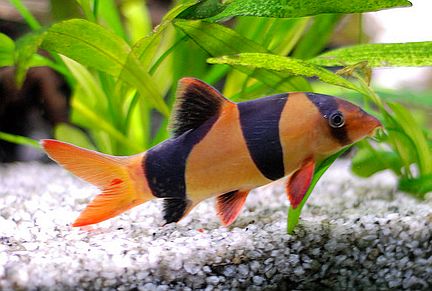The Clown Loach (Botia macracantha) is a peaceful schooling fish native to the inland waters in Indonesia on the islands of Sumatra and Borneo.
In their native habitat, the Clown Loach is found in fast moving streams with water temperature ranges between 77 and 86 °F, a pH between 5.0 and 8.0, and water hardness between 5 and 12 dH. For a good portion of the year, monsoons force the Clown Loach into blackwater river areas and murky water conditions encountered when the plains become flooded.
Clown Loaches get their name from their bright colors. The main body is light to bright orange with three wide black, triangular, vertical bands that gives it it’s unmistakeable appearance. The front band runs from the top of the head through the eye, the middle band runs between the head and the dorsal fin and wraps around the body, and the rear band wraps around the caudal and anal fins around the body. Clown Loaches are wide bodied fish that have a large moveable spine set in a groove below each of the fish’s eyes that is used for defense and holding onto rocks in swift currents.
Clown Loaches are shy fish and benefit from having live plants and river rocks in the aquarium to hide amongst. They appreciate having caves, holes, driftwood and other hiding places strategically positioned around heavy aquarium plantings.
The Clown Loach is one of the “must have” fish for tropical fish keeping enthusiasts. They get along well with most other members of a community tank and have some interesting habits like swimming upside down or on their sides, and laying on their sides and “playhing dead” on the botttom of the tank. This is normal behavior for these fish.
Unlike most nocturnal loaches, Clown Loaches are active during the day but need cover, and shy away from bright light. Because they are schooling fish, they do best in groups of 6 or more individuals and need a large tank with good water movement. When kept in groups smaller than five, they will spend a lot of time hiding. Since they grow up to a foot long in their natural environment, a 100 gallon tank or larger is not inappropriate to keep these fish happy. Clown Loaches are susceptible to Ichthyophthirius (ich) or white spot disease when stressed or subjeted to rapid water temperature changes.
Clown Loaches should be fed several small meals throughout the day instead of only once a day. They are omnivorous and will eat a variety of foods like vegetable flakes, “Pleco tablets”, live, frozen, or freeze-dried worms, brine shrimp, tubifex worms, and banana or other plant matter. Botia macracantha are voracious eaters of those nuisance snails that sometimes sneak into your aquarium on live plants.
Clown Loaches are normally available for purchase when they are 1″ to 1 1/2″ long. A 3″ to 4 1/2″ specimen is considered “large” however, they normally grow to almost one foot in length.

Clown Loach (Botia macracantha)
Minimum Tank Size: 100 gallons
Care Level: Moderate
Temperament: Semi-aggressive
Aquarium Hardiness: Very Hardy
Water Conditions: 72-86° F, KH 8-12, pH 6.0-7.5
Max. Size: 1′
Color Form: Black, Orange, Red, Tan
Diet: Omnivore
Compatibility: Good community tank fish
Origin: Indonesia
Family: Cobitidae
Lifespan: 15 years +
Aquarist Experience Level: Beginner


5 Responses to “Clown Loach (Botia macracantha)”
Trackbacks/Pingbacks
[…] peacefully kept with sharks of different species of the same size, rainbowfish, Botiid loaches, Clown loaches, Devarios, and other larger peaceful […]
[…] http://www.tropical-fish-keeping.com/clown-loach-botia-macracantha.html#sthash.mlu6JesX.dpbs […]
[…] Salvini, White Tip Sharks, Clown Knifefish, Tinfoil Barbs, Black Barred Tiger Fish, groups of large Clown Loaches, and even some of the larger freshwater eels like the Snowflake […]
[…] quite peaceful and can be kept with other peaceful, heat-loving species, such as cardinal tetras, clown loaches and rasboras. They should not be kept with angelfish which are prone to parasitic infestations and […]
[…] Clown Loach (Botia macracantha) […]